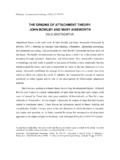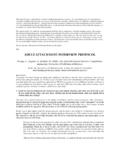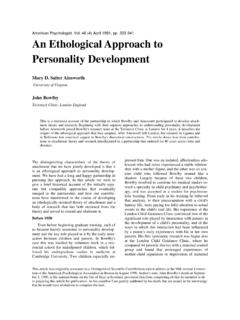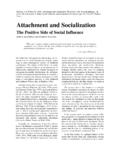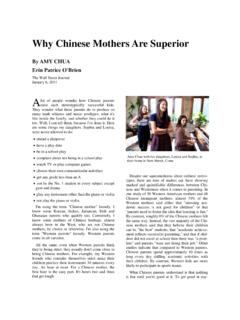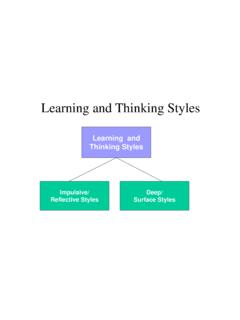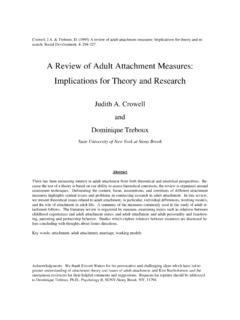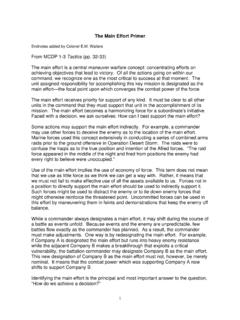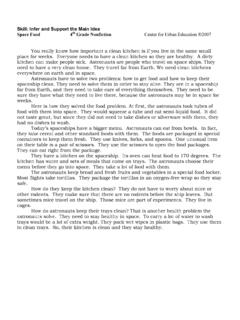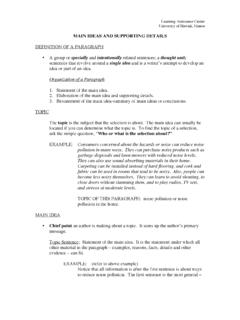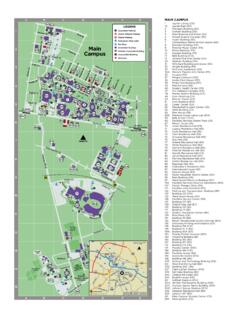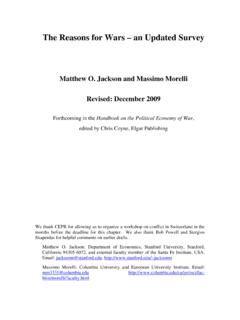Transcription of Explaining Disorganized Attachment - Stony Brook
1 In press (1999). J. Solomon & C. George (Eds). Attachment Disorganization . New York : Guilford Press. Explaining Disorganized Attachment :Clues From Research On Mild-to-ModeratelyUndernourished Children in ChileEverett WatersSUNY Stony BrookMarta ValenzuelaJewish General HospitalMontreal, Quebec, CanadaAbstractA wide range of data have demonstrated the Disorganized Attachment pattern can be scored reliably, hasgood discriminant validity vis a vis important alternative interpretations, and is related to significantdevelopmental outcomes. The challenge now is to understand Disorganized Attachment in terms ofdevelopmental mechanisms and activating conditions. Ideally, this would involve understanding Disorga-nized Attachment in terms of the operating characteristics of an underlying Attachment control , this is beyond the reach of current theory and methods.
2 Nonetheless, we can develop usefulhypotheses about mechanisms relevant to Disorganized Attachment and collect data that can help decideamong alternative hypotheses. This paper reports data on the stability of an Atypical Attachment patternobserved in thirty-four nutritionally healthy and 37 chronically undernourished and children from animpoverished neighborhood in Santiago, Chile. The hallmarks of this pattern were (1) clear avoidance (orresistance) in the first reunion and then a change to clear resistance (or avoidance) in the second reunion or(2) a mixture or A and C behaviors across preseparation, separation, and reunion episodes. Thus most metMain & Solomon s (1990) sequential contradictory behavior criterion for Disorganized Attachment . Thekey findings were (1) very high rates of Atypical Attachment in mild-to-moderately undernourished18-month olds, (2) marked decline in the frequency of Atypical Attachment (without improvement innutritional status) at a 28-months, and (3) the fact that Atypical infants most often became good examplesof standard insecure Attachment patterns.
3 Neither the high rate of Atypical Attachment patterns nor theirtendency to become typical insecure Attachment patterns with age were predicted from Attachment theoryor previous research. The results are discussed in terms of mechanisms underlying the disorganizedattachment pattern. In light of the possibility that there is important diversity within the disorganizedattachment category, investigations of new populations, collaborative research, and meta-analysis deservehigh priority in research on key correspondance to Dr. Everett Waters, Department of Psychology, SUNY, Stony Brook , New York, data for this study were collected as part of a longitudinal study of nutrition and socio-emotional development de-signed and directed by Dr. Marta Valenzuela with the generous support of the Nestle of Bowlby s primary goals in developingmodern Attachment theory was to preserveFreud s genuine insights about close relation-ships.
4 In order to accomplish this, Bowlbyreplaced Freud s view of Attachment as a bondbased on mental energy with the concept ofattachment as a secure base relationship orga-nized by a behavioral control system. The hall-marks of infant secure base behavior are (1)exploration away from the caregiver, (2) moni-toring the caregiver s accessibility during explo-ration, (3) increased alertness to or proximity tothe caregiver under circumstances that wouldimpede monitoring or access, (4) preferential- 2 -Waters & Valenzuelaproximity and contact seeking in the face ofuncertainty or threat, and (5) finding comfort inproximity and contact. In contrast to psychoan-alytic and social learning views of the infant asclingy and demanding, Bowlby envisioned anactive inquisitive infant, intent on explorationand mastery and all the more able to pursue thesegoals for its confidence in an Attachment figure savailability, responsiveness, and these behaviors are employed in an orga-nized way and with respect to just one or a fewcaregivers across time and across situations,they are referred to as the secure base systems theory enabled Bowlby toexplain the complexity, environmental and situa-tional sensitivity, developmental adaptiveness,and apparently purposefulness of secure basebehavior without invoking unverifiable psycho-logical constructs or endowing the infant withunlikely cognitive sophistication.
5 Control sys-tem models are also a useful way of formalizingideas about the organization of the secure basephenomenon (Bischoff, 1975; Bretherton, 1985;Waters, 1981). They also anchor Bowlby s andAinsworth s concept of Attachment security. Se-cure Attachment is closely linked to the notion ofa well configured, well functioning control sys-tem. Although researchers have shown littleinterest in parametric analysis of secure basefunctioning, this framework has served as auseful conceptual tool and guide to assessmentfor over 30 is somewhat surprising therefore that thecontrol system perspective does not anticipate orsuggest a second powerful device that has servedattachment theory and research for just as is the notion of patterns of Attachment . Thecontrol system model emphasizes the skilled na-ture of secure base behavior.
6 Within this per-spective, Attachment security is just a matter ofsome infants being more skillful at secure basebehavior than others. A continuum, fact, the situation appears more Mary Ainsworth pointed out, there is a widerange of individual differences in secure basebehavior. Not only are some infants more skilledthan others, there is quite a bit of diversity in thesecure base behavior of the more skilled infantsand even more among those whose secure basebehavior seems less skilled. This is particularlyevident under the stress of separation and re-union in the standard Strange Situation and par-ticularly during reunion episodes. Secure infantsare characterized by comfortable exploration inmother s presence, reduced exploration when sheleaves, positive greeting or proximity seekingwhen she returns, effective comforting by con-tact if needed, and return to preseparation levelsof exploration.
7 Within this framework, somesecure infants favor independent exploration,some prefer interactive play. Some cry duringseparation, others do not. And reunion behaviorranges from active distance interaction to closecontact. These patterns tend to be stable acrosstime and are entirely consistent with the organi-zation and adaptive function of the secure most surprising aspect of infant attach-ment behavior is that ineffective secure basebehavior in the Strange Situation finds two verydifferent expressions. Avoidant infants showlittle greeting or proximity seeking in reunionepisodes. They may in fact abort active ap-proaches, actively avert gaze, or ignore themother s call. They may also show flashes ofanger in their expression or cries. Mary main (1981) has suggested that at low levels thisbehavior heightens maternal Attachment behav-ior.
8 And indeed, mothers often chide avoidantinfants saying Oh, you re angry or Don t beangry and seeking to engage them or pick (ambivalent) infants are extremelydistressed by separation and yet approach behav-ior is weak or entirely absent when mother re-turns. In addition, they find little comfort incontact and are often angered if mother tries tocomfort them with a toy. They are sometimestermed ambivalent in reference to the fact thatthey mix weak contact maintaining with strongprotest if mother puts them on the floor. Ex-ploratory behavior rarely recovers to presepara-- 3 -Waters & Valenzuelation levels during the reunion the avoidant and the resistant patternsare not merely attenuated secure base behavior,they are entirely paradoxical. Both reflect dis-tress at separation and, from the point of view ofthe secure base phenomenon, self-defeating be-havior upon reunion.
9 Separation is the source ofthe infant s distress. And when mother returnsand greets them from the door, the solution totheir problem is at hand. They need only take they don t. The question is why?Each of these patterns has a certain coher-ence or logic to it. This has led some to suggestthat they are strategic ( main , 1990) even adap-tive in human evolution (Belsky, 1999). Inaddition, they are clearly discrete. That is, theyare not arbitrary divisions on a spectrum. Theyare also very consistent and have a wide range ofcompetence related correlates (Colin, 1996).And perhaps most surprisingly, the secure,avoidant, and resistant patterns have proven tobe useful prototypes for describing patterns ofattachment in adults ( main & Solomon, 1986)Not surprisingly, the primary attachmentclassifications (secure, avoidant, and resistant)and their subgroups were discovered early andrelatively few new groups have been added.
10 Thefirst was the B4 subgroup of secure infants are extremely distressed by separa-tion but, unlike resistant infants, they show ac-tive proximity seeking and contact importantly, they are comforted by contactand return to effective play as long as they arepermitted to stay close to mother or on her pattern was first noticed in Sylvia Bell s(1970) dissertation research and has becomequite familiar in subsequent research. The Dis-organized pattern described by main & Solomon(1986) has been the only widely accepted addi-tion to this secure, avoidant, and resistant at-tachment patterns are familiar, it would be toomuch to say that we fully understand an Attachment pattern involvesthree steps: identification, validation, and expla-nation. Identification is a matter of establishingthat the pattern exists.
